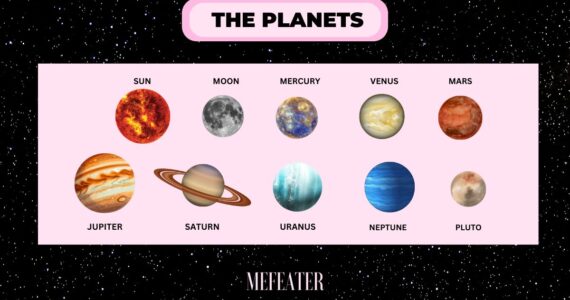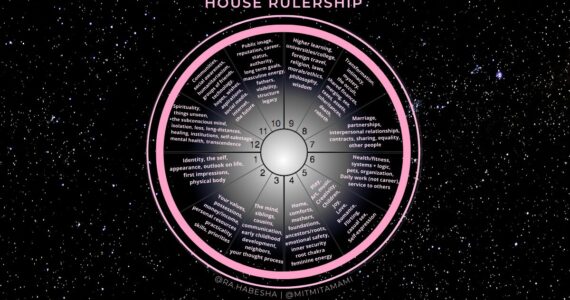A birth chart (aka a Natal Chart) is a snapshot of the sky the moment you were born; think of it as your cosmic fingerprint. To determine your birth chart, you need to have the date, location, and exact time of your birth. The exact time is required to calculate your birth chart properly — down to the minute. A birth chart marks the geographical positions and movements of each planet, moon, and star when you were born. Birth charts provide detailed insight into the energies that may prominently affect your life. In short, astrology studies how celestial bodies influence us — individually and collectively.
At its core, astrology revolves around three fundamental components: the zodiac signs, planets, and houses. Each of these elements provides layers of insight and works as an astrological formula to explain an astrological placement.
Zodiac Sign + House it’s in + Planet(s) in a house = Insight.
Below, we’ll outline a guide to reading your birth chart. Having baseline knowledge of planets, houses, and the zodiac signs is key to understanding your birth chart. Click each topic for an outline of the zodiac signs, houses, and planets.
There are three layers to a birth chart:
- Planets
- Houses
- Zodiac Signs
Zodiac Signs And Planets
Each zodiac sign holds an archetype of characteristics associated with it — whether positive or negative. For example, Aries are known to be fiery, bold leaders, while Capricorns are known for their stoic, hardworking ways. People typically associate our zodiac sign with our sun sign. Your sun sign is the constellation the sun was in the moment you were born. So if the sun was in the constellation of Leo when you were born (typically July 23 to Aug. 22), then you are a Leo or Leo sun. To learn more about the zodiac signs, click HERE.
However, people don’t typically realize that beyond the Sun, there’s significance in where each planet was when you were born. Every person also has a Moon, Mercury, Venus, Mars, Jupiter, Saturn, Neptune, Uranus, and Pluto sign, depending on the constellation each planet was in at that time. To learn more about the planets, click HERE.
Beyond planets, there are major asteroids and mathematical points that also impact us heavily. Specific points — rising sign, midheaven, and North/South nodes — are calculated depending on the exact time and location of your birth.
Houses
In astrology, a house is a slice of your birth chart that represents specific themes in life. For example, the second house (2H) rules everything related to your self-worth: value system, personal finances, belongings/possessions, resources, and resourcefulness. Each house rules a group of related life themes; the house rulership chart below details common themes for each house. Additionally, a house is colored by the planets residing in it and the energy of the zodiac sign they’re all residing in. To learn more about houses, click HERE.
A Guide to Reading Your Birth Chart
In order to read your chart effectively, it’s best to start by understanding your placements or where each planet on your birth chart lies. Let’s start with your big three (your sun, moon + rising signs).
Sun Sign
Your sun sign represents your character at its core. It’s who you generally identify as and your main personality traits. The sun illuminates our core identity and is the sign that people typically identify with (e.g., I’m a Leo! That is because the sun was in the constellation Leo when I was born). The sun rules the self, creativity, individualism, vitality, confidence, ego, and more.
*Some people do not relate to the general archetype of their sun sign at a glance. The introverted Leos, shy Aries, and bold Cancer placements may not relate to their stereotypical zodiac archetypes. However, most people do not account for their other placements or aspects, which adds a heavy layer of customization to who YOU are beyond your sun sign.
Moon Sign
Your moon sign represents your comfort zone, maternal figures, the home, and how you process/show your emotions. Your moon can express your emotionally intimate side; it’s the energy you don’t show to the entire world, just yourself and the people closest to you.
Ascendant or Rising Sign
Your rising sign represents the zodiac sign that was rising on the eastern horizon — at the exact time of your birth. The ascendant or rising sign is determined by the Earth’s rotation and changes approximately every two hours. As a result, it cycles through all 12 signs twice in 24 hours.
Your rising sign represents your physical and outward appearance, rules your viewpoint in life, and determines how you perceive the world around you. Knowing your rising sign is essential because it also impacts your houses and determines their rulers.

Now that you’re familiar with your big three, let’s move on to the rest of your placements. Your inner planets, aka personal planets, are the key players in your individual birth chart, representing the planets whose energies impact you the most. To learn more about how each planet affects us, click HERE.

Now that you’re familiar with your personal planets, we can move on to the outer planets, also known as generational planets. The generational planets include Jupiter, Saturn, Uranus, Neptune, and Pluto. *Though Pluto is debated as a planet, most astrologers tend to include Pluto in our readings, especially for people with prominent Scorpio placements or Pluto in the 1H.
Generational planets impact us individually, but more importantly, these slow-moving planets stay in position for years or decades, energetically leaving a fingerprint on a generation of people at a time. “Generations” as we know them (Millennials, Gen Z, Boomers) can be determined by generational planetary movements, particularly Pluto transits, which are the longest and can last 12 to 30 years.
Understanding each of your planetary placements is the beginning of decoding your birth chart. To learn more about Uranus, Neptune, and Pluto, click HERE. When starting with astrology, I always recommend looking at the wheel/circle and the table charts. Table charts help clearly define each planetary placement, like in the example below.

Now that you have a firm understanding of the planets, zodiac signs, and houses, you can layer the pieces of your birth chart. To do this, view your birth chart as a wheel/circle chart.

You can start at your first house (1H) or the slice on the left of your birth chart with a “1” inside of it. The first house represents your viewpoint in life, your physical appearance, and your demeanor. The zodiac sign that it’s in (Virgo, for the above example) is your rising sign, meaning your behavior and perspective resemble that sign’s archetype. Any planets in your first house (1H) also impact you.
Each slice of the wheel chart represents a house (1H-12H). To learn more about astrological houses, click HERE.
Now that you have an understanding of the planets, zodiac signs, and houses, you can apply this knowledge when reading your birth chart!
Each individual is different and has a variety of unique components that make them who they are. A birth chart is like your cosmic fingerprint. With a basic understanding of the planets, zodiac signs, and houses, you can understand the pieces of your birth chart and others. Astrology is a tool that can help you understand qualities about yourself, others, and the world around you. Using this knowledge is a tool that can help strengthen your self-awareness and improve your life.
*written for Tropical Astrology
Follow MEFeater on Twitter, Instagram, Facebook, and Pinterest for more Astrology tips and updates.









